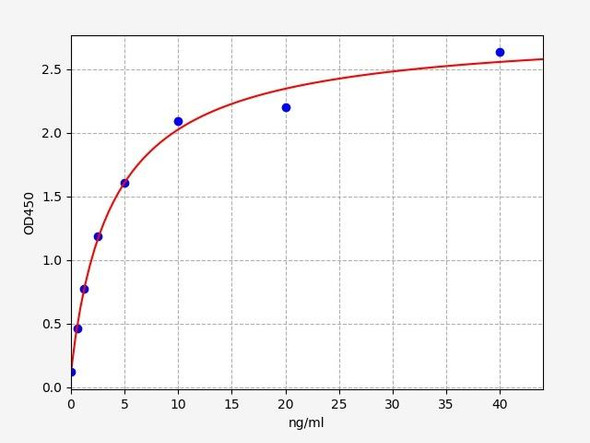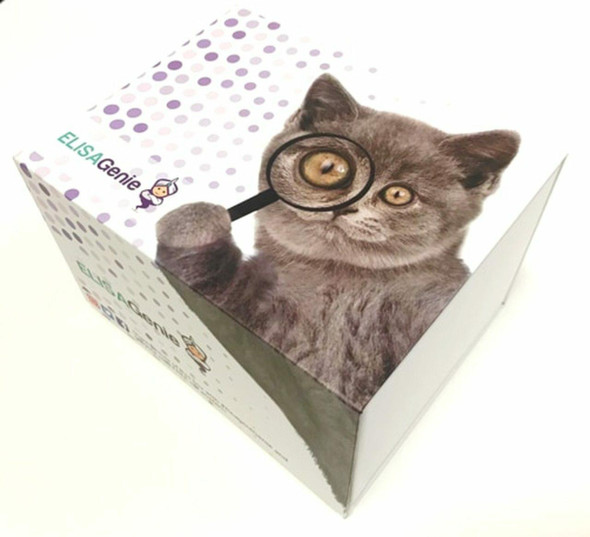Human STIP1(Stress Induced Phosphoprotein 1)ELISA Kit (HUES03564)
- SKU:
- HUES03564
- Product Type:
- ELISA Kit
- Size:
- 96 Assays
- Uniprot:
- P31948
- Sensitivity:
- 1.88ng/mL
- Range:
- 3.13-200ng/mL
- ELISA Type:
- Sandwich
- Reactivity:
- Human
- Sample Type:
- Serum, plasma and other biological fluids
- Research Area:
- Cell Biology
Description
Human STIP1 (Stress Induced Phosphoprotein 1) ELISA Kit
The Human STIP1 (Stress-Induced Phosphoprotein 1) ELISA Kit is specifically designed for the detection of STIP1 levels in human serum, plasma, and cell culture supernatants. This kit is highly sensitive and specific, providing accurate and consistent results for various research applications.STIP1 is a key protein involved in cellular stress response and is known to play a role in various diseases, including cancer, neurodegenerative disorders, and inflammatory conditions.
By measuring STIP1 levels, researchers can gain valuable insights into the mechanisms underlying these diseases and identify potential therapeutic targets.Overall, the Human STIP1 ELISA Kit offers researchers a reliable tool for studying the role of STIP1 in disease pathology and developing targeted treatment strategies.
| Assay type: | Sandwich |
| Format: | 96T |
| Assay time: | 4.5h |
| Reactivity: | Human |
| Detection Method: | Colormetric |
| Detection Range: | 3.13-200 ng/mL |
| Sensitivity: | 1.88 ng/mL |
| Sample Volume Required Per Well: | 100µL |
| Sample Type: | Serum, plasma and other biological fluids |
| Specificity: | This kit recognizes Human STIP1 in samples. No significant cross-reactivity or interference between Human STIP1 and analogues was observed. |
This ELISA kit uses Sandwich-ELISA as the method. The micro ELISA plate provided in this kit has been pre-coated with an antibody specific to Human STIP1. Standards or samples are added to the appropriate micro ELISA plate wells and combined with the specific antibody. Then a biotinylated detection antibody specific for Human STIP1 and Avidin-Horseradish Peroxidase (HRP) conjugate are added to each micro plate well successively and incubated. Free components are washed away. The substrate solution is added to each well. Only those wells that contain Human STIP1, biotinylated detection antibody and Avidin-HRP conjugate will appear blue in color. The enzyme-substrate reaction is terminated by adding Stop Solution and the color turns yellow. The optical density (OD) is measured spectrophotometrically at a wavelength of 450 nm ± 2 nm. The OD value is proportional to the concentration of Human STIP1. The concentration of Human STIP1 in samples can be calculated by comparing the OD of the samples to the standard curve.
| UniProt Protein Function: | STI1: a protein that is apparently involved in the response to stress. Specifically interacts with the C-terminal tails of Hsp70 and Hsp90 via TPR1 and TPR2A domains. Deletion of STI1 reduces the activity of the glucocorticoid receptor, a Hsp90 target protein. Phosphorylated in vitro by p90RSK and casein kinase II. |
| UniProt Protein Details: | Protein type:Chaperone Chromosomal Location of Human Ortholog: 11q13 Cellular Component: Golgi apparatus; nucleus Molecular Function:protein binding Biological Process: response to stress |
| NCBI Summary: | STIP1 is an adaptor protein that coordinates the functions of HSP70 (see HSPA1A; MIM 140550) and HSP90 (see HSP90AA1; MIM 140571) in protein folding. It is thought to assist in the transfer of proteins from HSP70 to HSP90 by binding both HSP90 and substrate-bound HSP70. STIP1 also stimulates the ATPase activity of HSP70 and inhibits the ATPase activity of HSP90, suggesting that it regulates both the conformations and ATPase cycles of these chaperones (Song and Masison, 2005 [PubMed 16100115]). [supplied by OMIM, Jul 2009] |
| UniProt Code: | P31948 |
| NCBI GenInfo Identifier: | 400042 |
| NCBI Gene ID: | 10963 |
| NCBI Accession: | P31948. 1 |
| UniProt Secondary Accession: | P31948,Q3ZCU9, Q5TZU9, B4DM70, F5H0T1, G3XAD8, |
| UniProt Related Accession: | P31948 |
| Molecular Weight: | 543 |
| NCBI Full Name: | Stress-induced-phosphoprotein 1 |
| NCBI Synonym Full Names: | stress-induced phosphoprotein 1 |
| NCBI Official Symbol: | STIP1 |
| NCBI Official Synonym Symbols: | HOP; P60; STI1; STI1L; HEL-S-94n; IEF-SSP-3521 |
| NCBI Protein Information: | stress-induced-phosphoprotein 1; NY-REN-11 antigen; Hsp70/Hsp90-organizing protein; hsc70/Hsp90-organizing protein; renal carcinoma antigen NY-REN-11; transformation-sensitive protein IEF SSP 3521; epididymis secretory sperm binding protein Li 94n |
| UniProt Protein Name: | Stress-induced-phosphoprotein 1 |
| UniProt Synonym Protein Names: | Hsc70/Hsp90-organizing protein; Hop; Renal carcinoma antigen NY-REN-11; Transformation-sensitive protein IEF SSP 3521 |
| Protein Family: | STIP1 homology and U box-containing protein |
| UniProt Gene Name: | STIP1 |
| UniProt Entry Name: | STIP1_HUMAN |
As the OD values of the standard curve may vary according to the conditions of the actual assay performance (e. g. operator, pipetting technique, washing technique or temperature effects), the operator should establish a standard curve for each test. Typical standard curve and data is provided below for reference only.
| Concentration (ng/mL) | O.D | Average | Corrected |
| 200 | 2.287 2.299 | 2.293 | 2.234 |
| 100 | 1.56 1.59 | 1.575 | 1.516 |
| 50 | 0.868 0.866 | 0.867 | 0.808 |
| 25 | 0.418 0.426 | 0.422 | 0.363 |
| 12.5 | 0.226 0.21 | 0.218 | 0.159 |
| 6.25 | 0.154 0.152 | 0.153 | 0.094 |
| 3.13 | 0.108 0.108 | 0.108 | 0.049 |
| 0 | 0.056 0.062 | 0.059 | -- |
Precision
Intra-assay Precision (Precision within an assay): 3 samples with low, mid range and high level Human STIP1 were tested 20 times on one plate, respectively.
Inter-assay Precision (Precision between assays): 3 samples with low, mid range and high level Human STIP1 were tested on 3 different plates, 20 replicates in each plate.
| Intra-assay Precision | Inter-assay Precision | |||||
| Sample | 1 | 2 | 3 | 1 | 2 | 3 |
| n | 20 | 20 | 20 | 20 | 20 | 20 |
| Mean (ng/mL) | 10.92 | 29.63 | 68.85 | 9.91 | 26.81 | 69.67 |
| Standard deviation | 0.76 | 1.77 | 3.01 | 0.55 | 1.23 | 2.29 |
| C V (%) | 6.96 | 5.97 | 4.37 | 5.55 | 4.59 | 3.29 |
Recovery
The recovery of Human STIP1 spiked at three different levels in samples throughout the range of the assay was evaluated in various matrices.
| Sample Type | Range (%) | Average Recovery (%) |
| Serum (n=5) | 94-108 | 99 |
| EDTA plasma (n=5) | 85-99 | 91 |
| Cell culture media (n=5) | 94-106 | 101 |
Linearity
Samples were spiked with high concentrations of Human STIP1 and diluted with Reference Standard & Sample Diluent to produce samples with values within the range of the assay.
| Serum (n=5) | EDTA plasma (n=5) | Cell culture media (n=5) | ||
| 1:2 | Range (%) | 98-113 | 83-97 | 87-97 |
| Average (%) | 105 | 90 | 92 | |
| 1:4 | Range (%) | 85-97 | 87-97 | 87-101 |
| Average (%) | 92 | 92 | 94 | |
| 1:8 | Range (%) | 91-109 | 86-101 | 82-94 |
| Average (%) | 99 | 92 | 89 | |
| 1:16 | Range (%) | 91-102 | 85-98 | 85-98 |
| Average (%) | 97 | 90 | 91 |
An unopened kit can be stored at 4°C for 1 month. If the kit is not used within 1 month, store the items separately according to the following conditions once the kit is received.
| Item | Specifications | Storage |
| Micro ELISA Plate(Dismountable) | 8 wells ×12 strips | -20°C, 6 months |
| Reference Standard | 2 vials | |
| Concentrated Biotinylated Detection Ab (100×) | 1 vial, 120 µL | |
| Concentrated HRP Conjugate (100×) | 1 vial, 120 µL | -20°C(shading light), 6 months |
| Reference Standard & Sample Diluent | 1 vial, 20 mL | 4°C, 6 months |
| Biotinylated Detection Ab Diluent | 1 vial, 14 mL | |
| HRP Conjugate Diluent | 1 vial, 14 mL | |
| Concentrated Wash Buffer (25×) | 1 vial, 30 mL | |
| Substrate Reagent | 1 vial, 10 mL | 4°C(shading light) |
| Stop Solution | 1 vial, 10 mL | 4°C |
| Plate Sealer | 5 pieces | |
| Product Description | 1 copy | |
| Certificate of Analysis | 1 copy |
- Set standard, test sample and control (zero) wells on the pre-coated plate and record theirpositions. It is recommended to measure each standard and sample in duplicate. Note: addall solutions to the bottom of the plate wells while avoiding contact with the well walls. Ensuresolutions do not foam when adding to the wells.
- Aliquot 100µl of standard solutions into the standard wells.
- Add 100µl of Sample / Standard dilution buffer into the control (zero) well.
- Add 100µl of properly diluted sample (serum, plasma, tissue homogenates and otherbiological fluids) into test sample wells.
- Cover the plate with the sealer provided in the kit and incubate for 90 min at 37°C.
- Aspirate the liquid from each well, do not wash. Immediately add 100µL of BiotinylatedDetection Ab working solution to each well. Cover the plate with a plate seal and gently mix. Incubate for 1 hour at 37°C.
- Aspirate or decant the solution from the plate and add 350µL of wash buffer to each welland incubate for 1-2 minutes at room temperature. Aspirate the solution from each well andclap the plate on absorbent filter paper to dry. Repeat this process 3 times. Note: a microplatewasher can be used in this step and other wash steps.
- Add 100µL of HRP Conjugate working solution to each well. Cover with a plate seal andincubate for 30 min at 37°C.
- Aspirate or decant the solution from each well. Repeat the wash process for five times asconducted in step 7.
- Add 90µL of Substrate Reagent to each well. Cover with a new plate seal and incubate forapproximately 15 min at 37°C. Protect the plate from light. Note: the reaction time can beshortened or extended according to the actual color change, but not by more than 30min.
- Add 50 µL of Stop Solution to each well. Note: Adding the stop solution should be done inthe same order as the substrate solution.
- Determine the optical density (OD value) of each well immediately with a microplate readerset at 450 nm.











